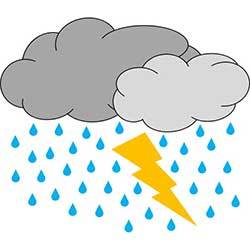For most dogs, going outside to potty and play is the best part of their day! It's something they look forward to constantly. They'll jump at any opportunity they can to enjoy the fresh air and all the sights and sounds that come with it.
While that excitement may be undeniable for most dogs out there,
some have a less-than-stellar reaction to going outside.

If your dog is exhibiting signs of fear or distress when they go outside, it's important to address the problem as soon as possible.
That fear is coming from somewhere. Knowing how to identify the cause of fear is the first step to helping your dog recover.
12 Common Reasons Why Dogs Are Scared to Go Outside
#1. Bad Memories
Has your dog ever had an unpleasant experience outside? Maybe they were stung by a bee or slipped on some wet pavement. If so, the memories of that even could be causing some anxiety in your dog.
Canines are cunning creatures. They remember events just like you do. Unfortunately, they often generalize those negative memories, resulting in irrational fears of things they can't avoid.
If that the case with your dog, going outside might be a trigger for them. They are scared that going outside is going to cause that event to happen again. So, they'd rather just avoid it altogether and stay inside as much as possible.
#2. Unfamiliar Territory
This is pretty common when families move to a new home.
It can be very confusing for a new dog to be in a completely different environment than they are used to. This is especially true if the move was drastic.
Say for example, that you moved from a rural area with wide-open spaces to the middle of a bustling city. There's a lot of unknowns hiding beyond those doors!
Your dog is unfamiliar with his or her surroundings and needs some time to adjust. The good news is that this fear will usually subside once your pooch gets a bit more acquainted with their new home.
#3. Unfamiliar Weather Experiences

Sometimes, new physical experiences could cause some uneasiness with your canine companion. Has your dog ever encountered snow, heavy winds, or thunderstorms?
If your house is well-insulated and quiet, there's a good chance that they have no concept of changing weather patterns. So, the first time you bring them out in less-than-ideal weather is going to be a nightmare!
That sudden burst of wind or crash of thunder could send them running back to the safety of your house.
Related: Walking the Dog in the Rain – 8 Tips to Keep your Pet Safe
#4. Uncomfortable Using a Leash
Similar to what happens when you move to a new home, exposing your dog to brand-new things could be causing some anxiety. Rescue dogs, in particular, are notorious for developing fears because of relatively benign things.
Take, for instance, walking on a leash. If your dog has never been trained to walk on a leash, they will not like the feeling of being confined. Putting a leash around their neck is something that's completely foreign to them.
They don't know what it is. All they do know is that the leash only comes out when they're going outside.
#5. Sensitivity to Sound
Loud and unexpected sounds are a pretty common source of fear for dogs. It's important to remember that canines have very sensitive hearing.
They can hear frequencies that are far beyond our capabilities. Plus, they can sometimes hear sounds from many miles away.
The outside world is filled with unexpected noise. Cars passing by, humans talking, the whirring of construction equipment, and much more are all brand-new things your dog doesn't experience regularly.
Your home is a quiet and safe space for them to enjoy your company in silence. Suddenly being hit with a wall of sound is enough to send even the most mild-mannered dog into a tizzy.
#6. Feeling of Being Overwhelmed
Young dogs can feel overwhelmed very easily the first time you try to take them outside. They spent most of their young lives being protected by their mothers, siblings, and caretakers.
All puppies experience some form of anxiety when you first bring them home.
Eventually, those feelings go away as they get acclimated to this new way of life. Unfortunately, all of the new things they see, hear, smell outside take a bit longer to overcome.
All of that sudden exposure is overwhelming to your young pup's brain. Their natural instinct is to just flee.
While it can put a halt on their training, it's important to be patient and give your pooch some time to adjust.
#7. Poor Socialization
Speaking of young puppies, one of the best things you can do for a dog is to provide them with proper socialization.
During the first 16 weeks of life, they must socialize with all types of animals and people. Otherwise, they could encounter fear later on in life.
Have you ever encountered a dog that seemed to harbor some kind of prejudice towards a certain type of person? Nine times out of ten, it's because the dog never had a chance to socialize with them when they were young.
As a result, they become fearful. Socializing your dog at a very early age is key if you want them to become a well-rounded adult.
#8. Bad Former Training
While training is supposed to reinforce positive traits, it can also lead to some behavioral issues in dogs.
Negative reinforcement training is not great for dogs. Causing any type of pain or discomfort as a means to dissuade a certain type of behavior will only instill fear in the dog.
If the dog has ever been trained with an electric fence, you might see some fear anytime its time to go outside. Whether this training came from you or a previous owner, it can have a lifelong effect.
The pain from those shocks makes the dog scared to go outside because they have associated the feelings with the yard rather than the fence.
#9. Pain or Injury
Physical pain is a pretty big deterrent for wanting to go outside. Even if you can't see anything wrong with your dog, they may be hurting. Keep an eye on their behavior and gently perform a physical examination.
Check the paws and legs first. Sometimes, broken or overgrown nails can make it painful for your dog to walk. There could also be a thorn or wood splinter stuck in their pad.
If your dog is exhibiting signs of lethargy, you may want to take them to a vet. Medical issues could be causing your dog pain whenever they get up or walk.
Your vet will be able to diagnose any major problems so that you can give your pup the relief they need.
#10. Senior Anxiety
Getting older does a lot to a dog's mind. They tend to develop anxiety issues more easily than a younger dog. They can associate recent negative events with going outside and become fearful of it. This is possible even if your dog has spent years going outside without any issues.

Moving to a new home can be particularly taxing on a new dog. Canine cognitive dysfunction is pretty common. It affects their memory and makes it harder to understand their surroundings.
When you expose them to a new location, they could grow anxious because they don't know how to adequately process it.
It takes time, but senior dogs can usually overcome those fears with regular exposure.
#11. Vision Problems
If your dog is suffering from vision problems, the issue is likely a fear of the unknown. Cataracts, glaucoma, and a host of other ocular conditions make it difficult for dogs to see clearly. It makes their vision appear burry.
Not being able to see plus unfamiliar sounds are the perfect recipe for fear. The key to overcoming this issue is to show your dog that there's nothing to be scared of.
#12. Fear of the Process
Finally, your dog might not actually be scared of the outdoors at all. Instead, they might be scared of the process of going outside. Take a look around your home and pay close attention to what your dog has to go through to get outside.
Do they need to climb down a set of stairs or walk over some hot concrete before they get to grass? If so, you might have found the issue.
All it takes is one negative event or uncomfortable situation for your dog to develop a complex. Encountering that issue every day becomes a stressful even. You can try using another exit method or providing your dog with an alternative path to the outdoors to help keep that anxiety at bay.
What You Can Do To Help Your Dog
Dealing with canine anxiety is a tricky thing. You don't want to push your dog over the limit. Their fears, no matter how ridiculous they may seem, are completely valid.
To successfully help your dog overcome their fears, you need to be patient, gentle, and vigilant. Here are a couple of training methods you can use.
Counter-Conditioning
Counter-conditioning is all about teaching your dog to enjoy the thing they fear the most. It involves removing the emotional and physical response they learned. To do that, most trainers will utilize treats and plenty of positive reinforcement.
Say, for example, that your dog is scared of all of those cars driving past. Well, when you're on your daily walks, give your dog some positive reinforcement any time that a car drives by. This teaches them that there's nothing to be afraid of.
De-Sensitization
De-sensitizing your dog is a lot like counter-conditioning. In fact, many trainers use the two methods together for the biggest effect. The biggest difference is that de-sensitizing your dog is about exposing them to the trigger slowly over time.
If your dog is scared of lawnmowers, you can slowly expose them to the machines over time. Start out by showing them a lawnmower that's off. Because it's not making loud noises, the trigger is below the fear threshold.
Provide them with treats and positive reinforcement. Then, you can slowly up the ante until your dog is no longer afraid of the trigger.
* This method takes time and you need to be careful about exposing your dog to too much at one time.
Conclusion
Fear of the great outdoors is not normal for dogs. Canines are meant to thrive whenever they're outside, so it's important to address the issue as soon as possible. After finding out what the trigger is, work slowly to help them overcome their fears.
You can work alongside your vet or a trainer to help your dog move past those issues and enjoy the outdoors as nature intended it
Also read:

